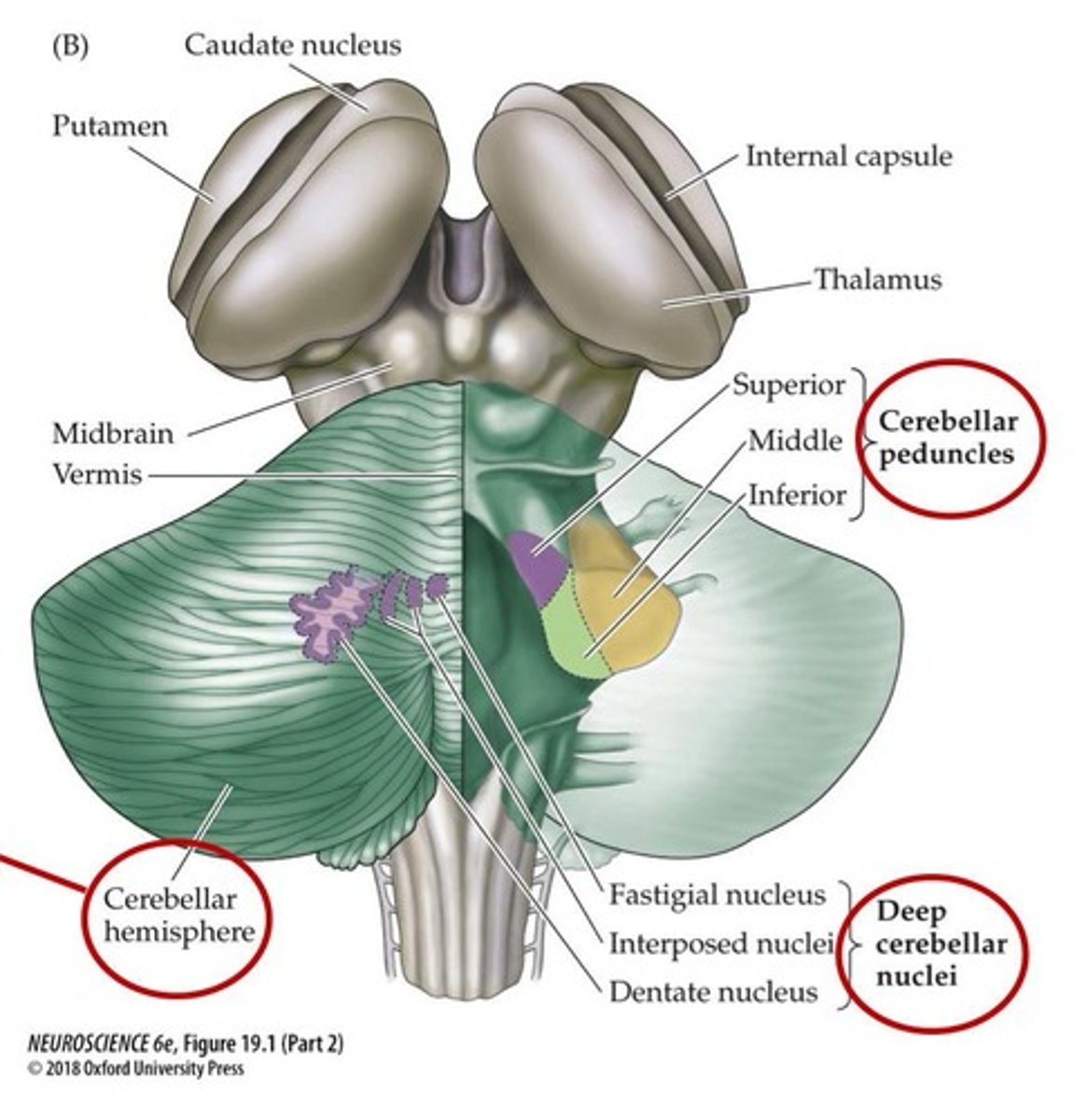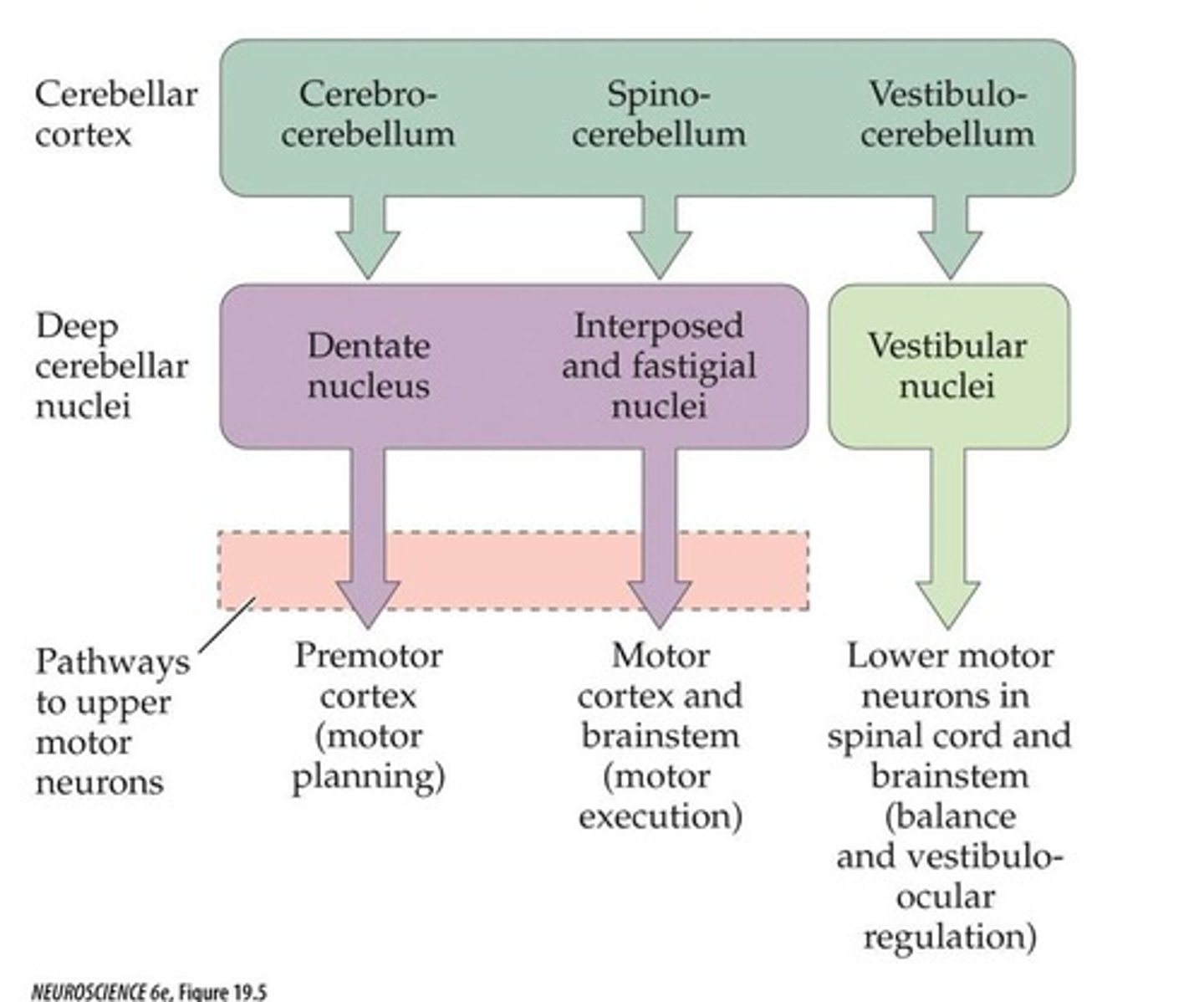Key Concepts for Exam 2: Visual Pathways and Movement Control
1/67
There's no tags or description
Looks like no tags are added yet.
Name | Mastery | Learn | Test | Matching | Spaced |
|---|
No study sessions yet.
68 Terms
Optic nerve
Transmits visual information from retina to brain.
Contralateral
Refers to opposite side processing in the brain.
Retinotopic maps
Neurons represent adjacent spatial areas in vision.
Lateral geniculate nucleus (LGN)
Processes visual information from both retinas.
Primary visual cortex (V1)
Initial cortical area for visual processing.
Ideal stimulus for V1 cells
Oriented lines or edges in visual field.
Where pathway
Processes spatial location; involves parietal lobe.
What pathway
Processes object recognition; involves temporal lobe.
Neurons in MT
Responsive to direction of motion in vision.
Akinetopsia
Loss of motion perception due to MT damage.
Neurons in V4
Responsive to color information in visual stimuli.
Achromatopsia
Loss of color perception due to V4 damage.
Neurons in IT
Responsive to complex visual objects and faces.
Prosopagnosia
Face blindness due to damage in FFA.
Motor unit
Single motor neuron and its muscle fibers.
Neuromuscular junction
Site where motor neuron stimulates muscle contraction.
Fast-Fatigable motor units
Generate quick, powerful contractions but fatigue quickly.
Fast Fatigue-Resistant motor units
Sustain activity longer than fast-fatigable units.
Slow motor units
Maintain posture; resistant to fatigue.
Local circuit neurons
Connect nearby motor neurons for coordinated movement.
Central pattern generators
Generate rhythmic locomotor behaviors through reflexes.
Cranial nuclei/nerves
Control head and neck movements; lower motor neurons.
Upper motor neurons
Control voluntary movements; located in brain.
Primary motor cortex (M1)
Initiates voluntary movement upon stimulation.
Corticospinal Tract
Pathway for complex voluntary movements.
Corticobulbar Tract
Controls facial and neck muscles.
Premotor Cortex
Involved in planning movements.
Mirror Neurons
Activate during observed and executed movements.
Cerebellum
Coordinates ongoing movement and balance.

Cerebellar Ataxia
Impaired balance, coordination, and movement precision.
Deep Cerebellar Nucleus
Processes motor commands and sensory feedback.

Efferent Copy
Copy of motor command sent to cerebellum.
Purkinje Cells
Inhibit deep cerebellar nuclei output.
Basal Ganglia
Regulates initiation and suppression of movement.
Direct Pathway
Excites movement via basal ganglia structures.
Indirect Pathway
Inhibits movement through basal ganglia structures.
Dopamine D1 Receptors
Excite neurons, enhancing movement initiation.
Dopamine D2 Receptors
Inhibit neurons, reducing movement initiation.
Parkinson's Disease
Loss of midbrain dopamine neurons causes motor issues.
Huntington's Disease
Genetic disorder causing uncontrolled movements.
Motor Stiffness
Rigidity and slowness in movement characteristic of Parkinson's.
Impulse Control Disorders
Side effect of Parkinson's treatment with dopamine.
Cerebellar Feedback
Adjusts movements based on expected vs. actual outcomes.
Vestibular System
Senses balance and spatial orientation.
Reticular Formation
Regulates arousal and motor control.
Autonomic Dysfunctions
Symptoms like constipation and low blood pressure in Parkinson's.
Dopamine
Neurotransmitter involved in reward signaling.
Taste Neuron Activation
Activated by direct or indirect signaling.
Labeled Line
Conveys specific taste information via ganglion cells.
Motivated Behavior
Actions driven by internal needs or desires.
Neurotransmitters
Produced in neurons, affect nearby cells.
Hormones
Produced in glands, released into bloodstream.
Ghrelin
Hormone released from stomach, stimulates hunger.
Leptin
Hormone from adipose tissue, decreases food intake.
GLP-1
Released from intestines, promotes weight loss.
AgRP/NPY Neurons
Promote hunger, inhibit energy expenditure.
POMC Neurons
Induce satiety, increase energy expenditure.
Cerebellum Function
Coordinates movement, balance, and posture.
Ataxia Symptoms
Impaired coordination and balance.
Purkinje Cells
Involved in motor coordination within cerebellum.
Direct Pathway
Facilitates movement via excitatory signals.
Indirect Pathway
Inhibits movement through complex signaling.
Substantia Nigra
Brain region critical for movement control.
Striatum
Integrates signals for motor control.
D1 Receptors
Excitatory dopamine receptors in the brain.
D2 Receptors
Inhibitory dopamine receptors in the brain.
Blood-Brain Barrier
Limits substance passage to protect the brain.
Second-Order Neurons
Regulate eating based on upstream neuron signals.